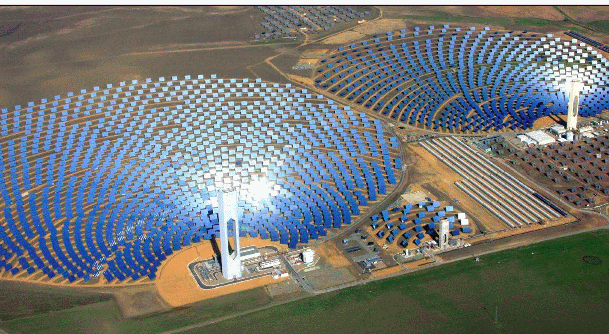The Australian Renewable Energy Agency has finally come to an agreement with the privately-owned Alinta to co-fund a feasibility study into a solar thermal power station to augment or replace the existing coal fired generators in the South Australian township of Port Augusta.
ARENA announced on Wednesday it would contribute $1million to the study, with $1.2 million to come from Alinta and a further $123,000 from the state government.
However, the study would not conclude until 2016, which may dash hopes for an earlier start to the project and a near-term replacement for the ageing Playford and Northern coal-fired power stations. Alinta recently said it wanted to extend the life of its two coal fired power stations for another two decades.
 Solar thermal technology has been around for a couple of decades, but the arrival of new technology including solar power towers and molten salt storage means it is once again emerging as an exciting renewable energy option. Abengoa this year opened a 280MW parabolic trough and storage facility in California and recently announced it will build a 110MW solar power tower plant with 17.5 hours storage in Chile. It has already begun construction of a 50MW project in South Africa.
Solar thermal technology has been around for a couple of decades, but the arrival of new technology including solar power towers and molten salt storage means it is once again emerging as an exciting renewable energy option. Abengoa this year opened a 280MW parabolic trough and storage facility in California and recently announced it will build a 110MW solar power tower plant with 17.5 hours storage in Chile. It has already begun construction of a 50MW project in South Africa.
BrightSource Energy is preparing to open its 377MW Ivanpah solar tower project in California, the largest in the world, while Solar Reserve is nearing completion of its 110MW solar tower project with storage in Nevada.
In Australia, the only major solar thermal project is a 44MW solar thermal booster to the Kogan Creek power station in Queensland, currently under construction. However, the Clean Energy Finance Corporation last year said it would support a 36MW solar thermal project in Port Augusta to provide heat and power to a giant greenhouse.
There has been a major push by the local community and green energy groups for solar thermal generation in Port Augusta. Earlier attempts at reaching agreement for a study failed last year when Alinta said it would walk away from the idea after failing to get funding. However, ARENA said at the time it did not consider the matter closed.
ARENA CEO Ivor Frischknecht said in a statement on Wednesday the feasibility study would provide an exciting opportunity to progress solar thermal in Australia.
“Tapping into our plentiful solar resources will ensure renewables are well placed to contribute to electricity generation in Australia,” he said.
“This latest partnership is an important step in our renewables journey – it complements existing solar thermal projects in Australia and will help create a framework of research, development and demonstration.”
Frischknecht said the study would look into hybridised and standalone solar thermal power generation options for Port Augusta.
“Many of our coal fired power stations are nearing the end of their life cycle, presenting a clear opportunity for renewable hybrid options,” Frischknecht said. “This timely study in South Australia will include a full feasibility stage exploring plant design, site and technical details.”
There have been other studies of hybridisation, but industry sources have told RenewEconomy that this can be difficult and costly when done with old power plants. Kogan Creek is relatively modern.
The Repower Port Augusta Alliance said a hybrid plant would not deal with our communities ongoing health concerns from the coal stations. “A solar/coal hybrid is just putting an old polluting power station on life support. Alinta and the government need to ensure we are investing in a full solution for our community which means solar thermal with storage, a technology which is operating around the world”, it said in a statement.
RenewEconomy’s view: It’s frustrating that while new solar thermal plants – with storage – are being built in the US, Chile and South Africa, and considered in China, the Middle east and north Africa, while in Australia we are committing to yet more feasibility studies, five years after the Solar Flagships program was first unveiled.
There are some reasons for this, none of them satisfactory. One is the uncertainty over carbon and clean energy policy. No large scale renewable plants can be committed to while the renewable energy target is under review, and there is a threat that the RET could be removed, or significantly diluted.
Another reason is that Alinta has an economic interest in keeping its coal-fired generators as long as possible. More renewable energy dilutes its returns, as it does for other fossil fuel generators, which is why Alinta has been one of the more aggressive opponents of keeping the RET as is. Alinta, it should be remembered, is owned by private equity interests (including TPG, the owner of Myer), and they will want to make a clean, profitable and uncomplicated exit within a few years. That may explain the length of the feasibility study.
The third is that ARENA has been stripped of more than $400 million in funds, which will make it difficult to contribute to such large scale developments. Alinta said in 2012 that it would need $65 million from the government to consider such a project. In its current budgetary straight-jacket, it is difficult to see how ARENA could afford that, despite its commitment to hybrid renewable projects. It’s much more likely to do this in remote and off-grid areas, where the costs of electricity much high, and the economics of incumbent plant are not threatened.








